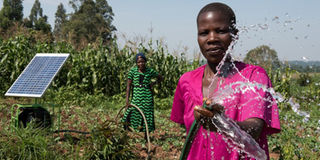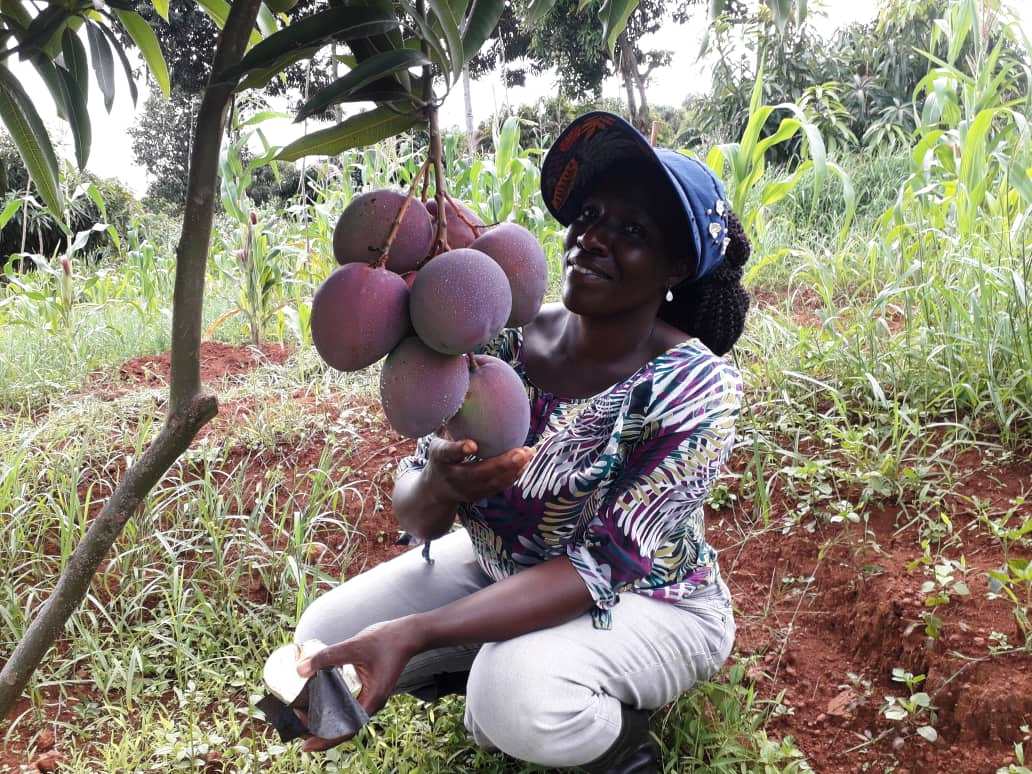Choosing the right solar powered irrigation system

A farmer watering plants next to a solar panel. Photo / Courtesy
What you need to know:
- In solar-powered irrigation systems, the water pump draws power from the solar panels or batteries charged using the solar panels, in order to provide a combination flow and pressure.
The use of solar power for irrigation is becoming popular as solar panel technologies continue to get better and cheaper. Using solar harnesses the energy from the sun, to pump water from wells, boreholes, dams, rivers, and other water sources.
This water is then used to provide water to plants, resulting in better produce for the farmer. Throughout history, the human race has been faced with the challenge of moving huge amounts of water from the source to the place where it is stored or used.
Traditional methods such as using human carriers and animals to ferry water could not meet the demand.
In modern times, water is moved by using pumps, powered by non-renewable energy sources such as diesel. Pumps have been also powered using electricity generated from both renewable sources and non-renewable sources.
For the farmer, the use of electricity to pump water for irrigation has its challenges. These include:
Cost
Electricity from power companies has recurring costs based on use, which can be high and unbearable and unpredictable to the farmer.
Reach
The second challenge, especially in Africa and Asia is that most power companies concentrate their supply in towns and cities where there is a high population of people. This is while ignoring the rural areas, where farmers grow food to feed the people in the cities. These two challenges make using solar-powered irrigation attractive to the farmer.
Importance of using solar
Solar power presents a great opportunity to bridge this gap, enabling the rural farmer to grow more food through irrigation. The advantages of solar-powered irrigation include:-
Solar energy is free
The energy from the sun is free. It is not mined such as fossil fuels. Apart from the initial cost of installation and the low cost of maintenance, you should be able to enjoy this free energy on your farm for many years to come.
Solar energy is renewable
Renewable energies, which includes solar, are energies that are not depleted in use. Solar energy is constantly replenished by nature. You simply cannot finish it.
Cuts on high power bills
With power companies’ ever-increasing power bills, solar energy for irrigation will cut on power bills. This is specifically where you will move the water pumping to solar, as you use electricity for other functions such as lighting.
Lower costs
The maintenance costs for solar energy are low. In some instances maintenance activities only include cleaning the solar panels. This is done about once every two years. Cleaning solar panels just involves using soap and water.
Flexible
This awesome energy is always available, even on cloudy and rainy days. This means the solar panels will still receive some energy from the sun, as long as they are installed well.
Multiple uses
If you install solar power for irrigation, you can use it for other purposes such as lighting, powering gadgets such as televisions and radios and charging devices such as phones and rechargeable torches.
Water source
The water source is a major component of your solar water irrigation system. The depth, distance, volume, and nature of the water source will determine the kind of components you need for your solar irrigation system installation. If water is being pumped from a distant location or a deep well or borehole, you will need a powerful pump and solar panels that supply more power to the pump as the system will need to do more work to move the water. More work means more power.
The volume of water will also determine the other components of the system. The amount of water you need to pump should be more or equal to the amount of water your pump can pump at a given time. If your pump can pump 10 litres a minute, then the water source should have at least 10 litres or refill at least 10 litres a minute. Some pumps can get damaged when there is no water to pump when the pump is running.
The solar panel
Solar panels will provide power to your pumps. These provide energy for your pump to be able to run. Power to the pump is measured in watts and also solar panels are rated in watts.
Whether the pump is pulling power directly from the solar panels or from solar batteries being charged by the solar panels, the solar panels for your irrigation system should be able to provide enough power to run the pump, which in turn moves the water.
The choice of solar panels for powering your irrigation system will be determined by how much power your pump needs.
Water pump
In solar-powered irrigation systems, the water pump draws power for the solar panels or batteries charged using the solar panels, in order to provide a combination flow and pressure. This combination is what moves the irrigation water from the source to the destination. Your choice of a solar-powered pump will be determined by the source of water – its depth, distance, nature, and volume.
Solar pump controller
A solar pump controller will be needed if your connection does not have batteries.
This is where you are connecting the solar panels to the pump. The work of the solar pump controller is to match the power from the panels to the power of the pump.
Solar pump controllers balance the current and voltage from the solar panels to the current and voltage required by the pump.
Water hose (pipe)
The piping for your solar-powered irrigation system is needed so as to move water from the source to the destination.
These are the conduits where your water for irrigation moves from the source, through the pump, to either your plot directly or to storage tanks.
Solar batteries
Solar batteries are used to store power from the panels for use to power the pump.
These are not needed in every solar-powered irrigation system, but come in handy where you need to pump water at night, when the solar panels are not receiving power from the sun.




